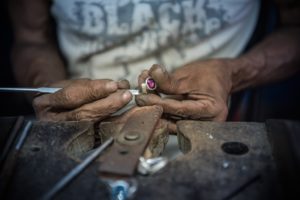 Behind every consumer good product – food, toy, cosmetic, apparel, etc. – there is a human being. Most of us have forgotten that and just see the product as an object. But the product has a story which can be long and complicated, much like a supply chain. A consumer good product is made out of several raw material ingredients that need to be produced, transformed and transported to their final destination. But have you thought of who produces and makes all of these products?
Behind every consumer good product – food, toy, cosmetic, apparel, etc. – there is a human being. Most of us have forgotten that and just see the product as an object. But the product has a story which can be long and complicated, much like a supply chain. A consumer good product is made out of several raw material ingredients that need to be produced, transformed and transported to their final destination. But have you thought of who produces and makes all of these products?
Today, even if the consumer good product is the best – in terms of taste, efficiency, look, etc. – there is still another aspect that cannot be forgotten: the price. And this sometimes becomes the most important part of the product. With globalization, a product can be transformed far from the store where it will be sold, in a country with cheap labor. Cheap labor usually implies low or inexistent labor laws, or even modern slavery or child labor. According to UNICEF, an estimation of 150 million children worldwide are engaged in child labor.
However, the laws are changing, especially in the developed countries.
- In the US in February 2016, after passing the Business Supply Chain Transparency on Trafficking and Slavery Act in July 2015, President Obama signed a law banning imported goods produced by child and forced labor. To enforce that law, the US Bureau of International Labor Affairs compiles an annual lists of goods produced by forced labor – i.e. electronics from Malaysia, fireworks from Peru, bricks from Vietnam, etc.
- In the UK, the Modern Slavery Act of 2015 is designed to tackle slavery in the UK and consolidates previous offenses relating to trafficking and slavery.
- In Canada, the World Vision Canada organization just released a report on child labor indicating that Canadian consumers may be unwittingly buying goods made by child laborers, but that they do not have the information to make an informed purchase decision. Therefore they are calling for a new law to ensure that factories in other countries that supply Canada aren’t using child labor.
And those laws are already making an impact.
In the US, a recent example involves PureCircle stevia, who has been asked by the US Customs and Border Protection to prove the stevia was not produced by forced labor. They have 3 months to justify the workforce used to produce Stevia and therefore compile a list of their entire supplier network. This product is used by companies like Coca-Cola, PepsiCo, and other popular sodas. This shows that one ingredient can impact several other companies, and maybe you.
Sources
- Obama Signs Law Banning Imported Goods Produced by Forced Labor, February 2016, http://www.nbcnews.com/news/us-news/obama-signs-law-banning-imported-good-produced-force-labor-n525901
- US impounds PureCircle stevia under new forced labour law; Singapore firm has stake in importer, June 2016, http://www.straitstimes.com/business/companies-markets/us-impounds-purecircle-stevia-under-new-law-singapore-company-has-stake
- An estimated 150 million children worldwide are engaged in child labour, UNICEF, March 2016, http://data.unicef.org/child-protection/child-labour.html
- Modern Slavery Act, 2015, http://www.legislation.gov.uk/ukpga/2015/30/contents/enacted
- New report on child labour raises call for supply chain transparency law, June 2016, http://www.timescolonist.com/new-report-on-child-labour-raises-call-for-supply-chain-transparency-law-1.2274235






